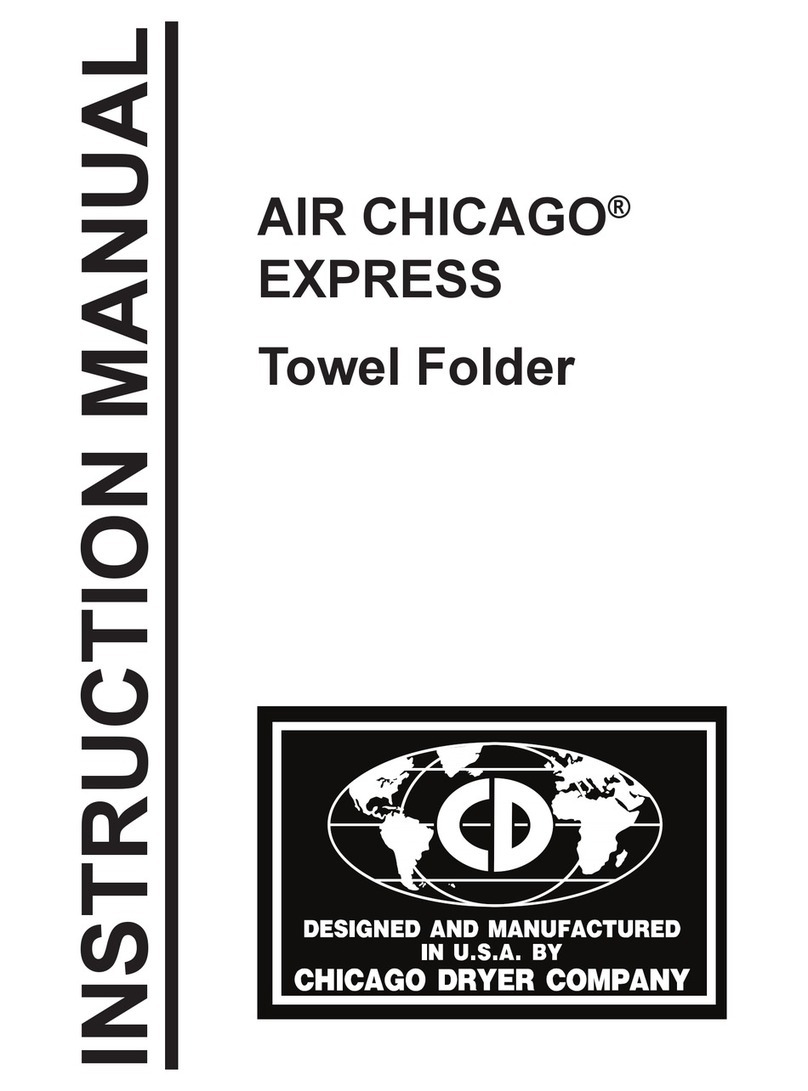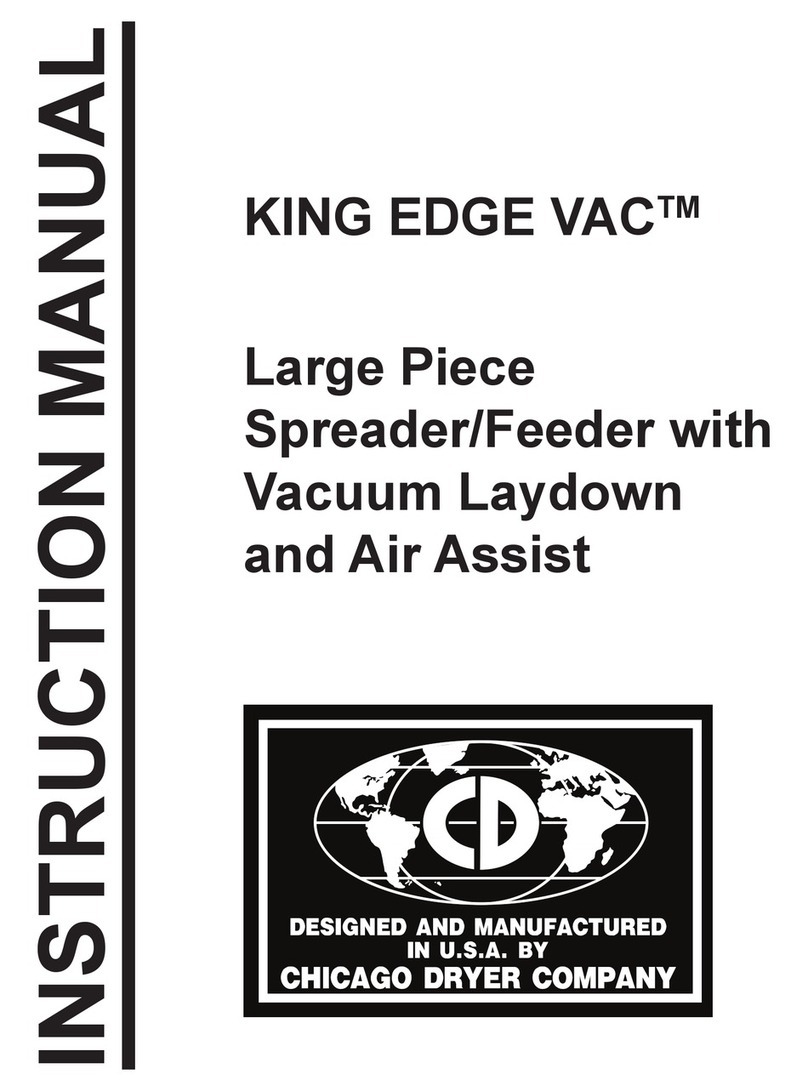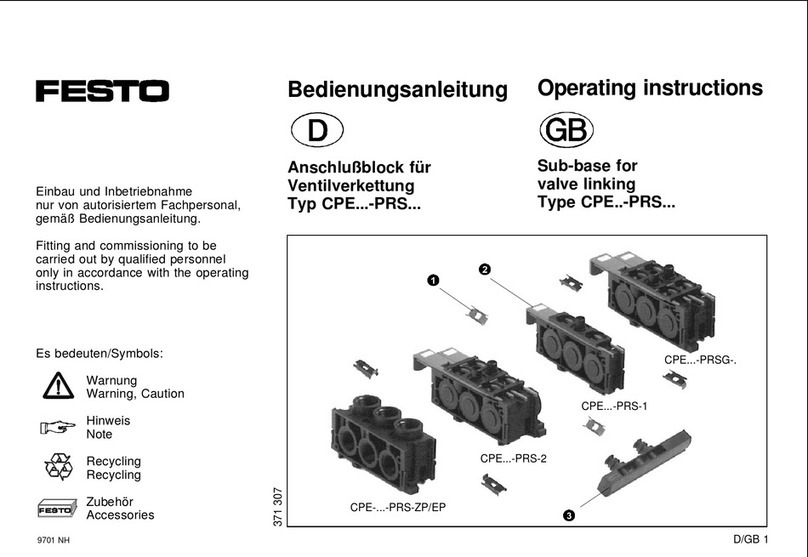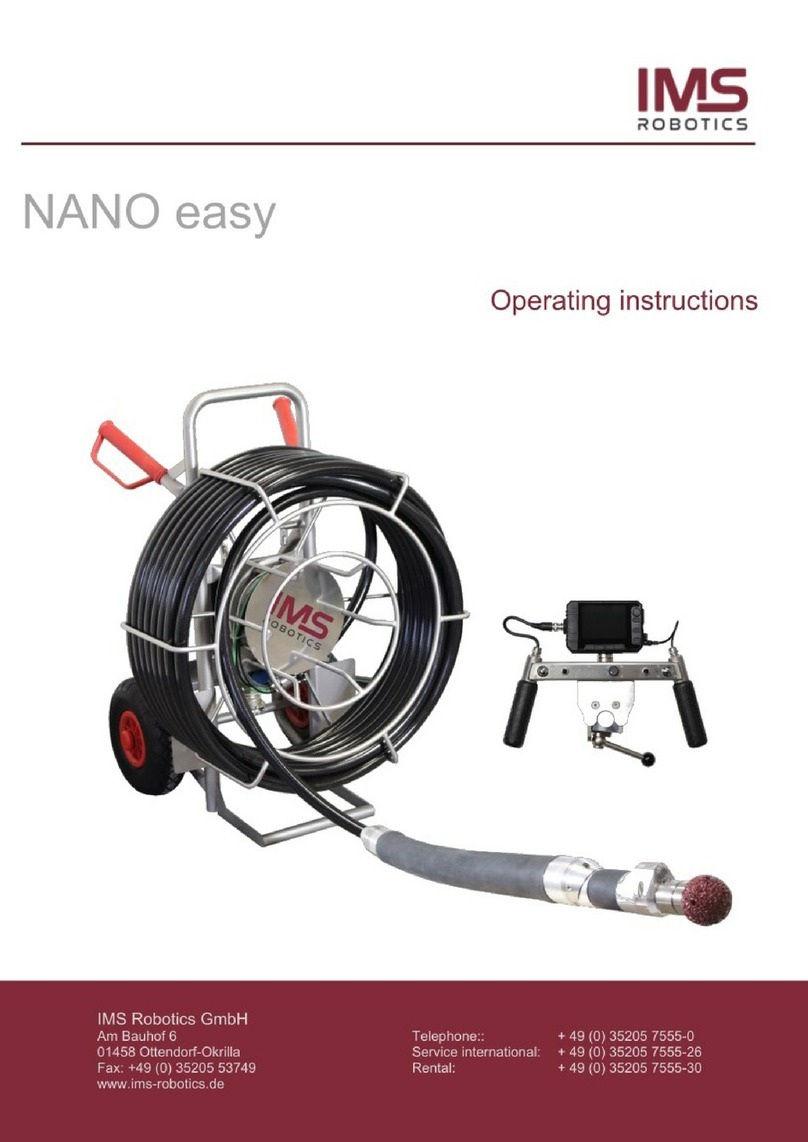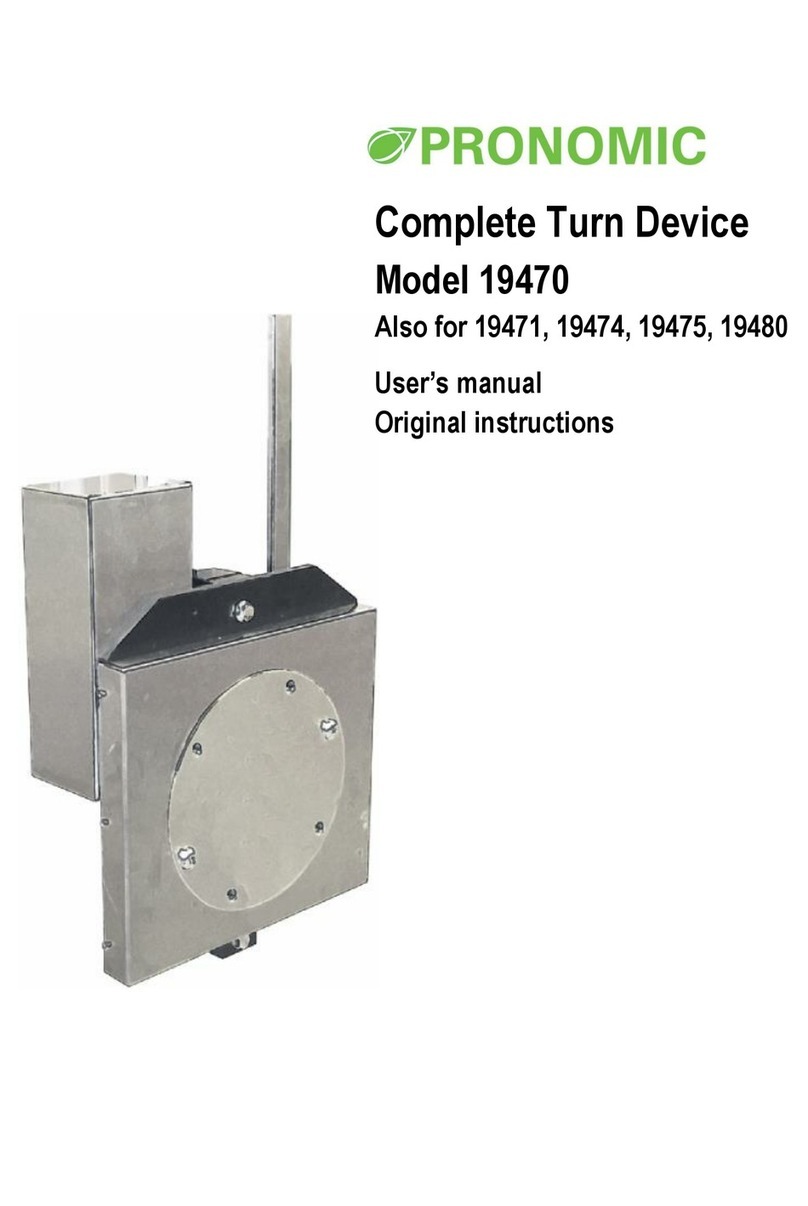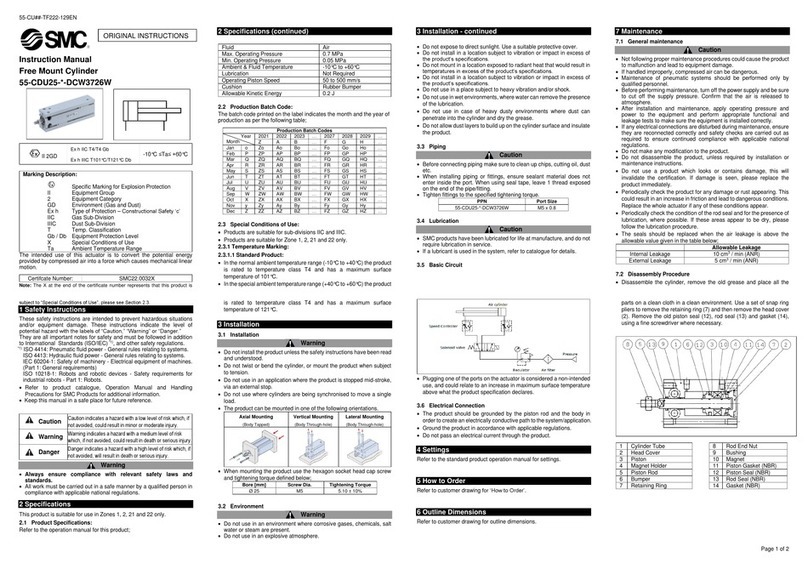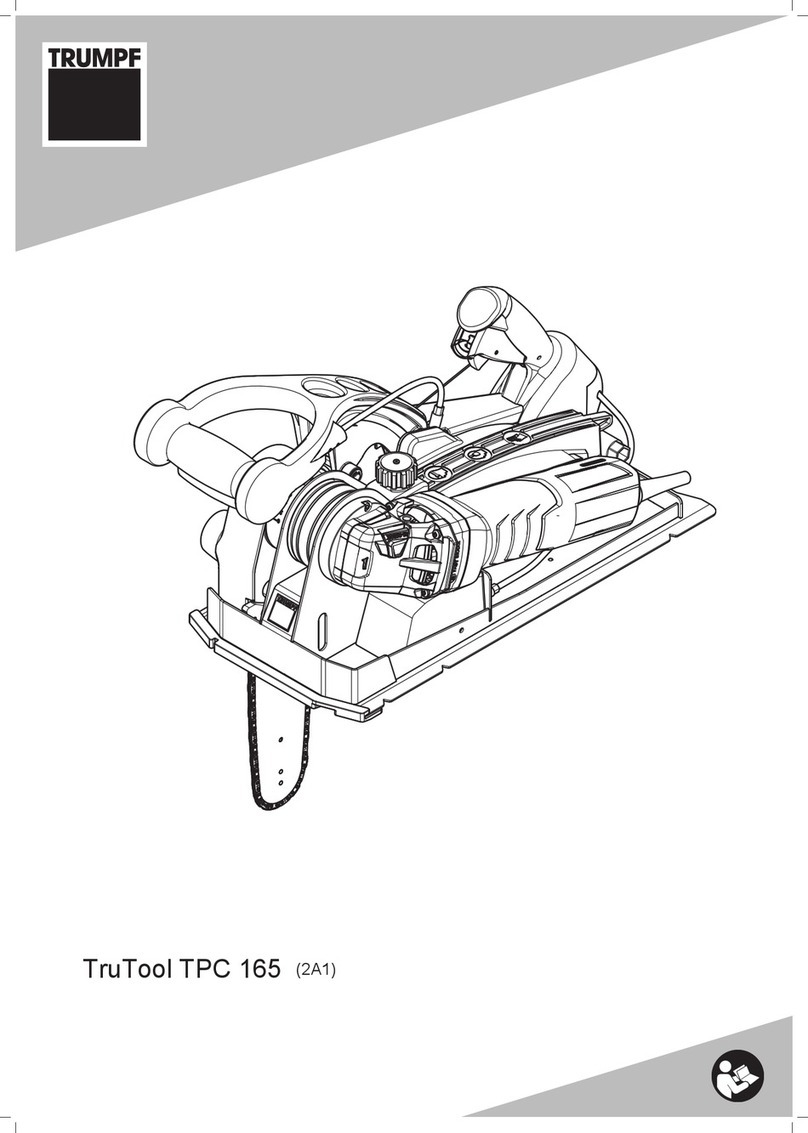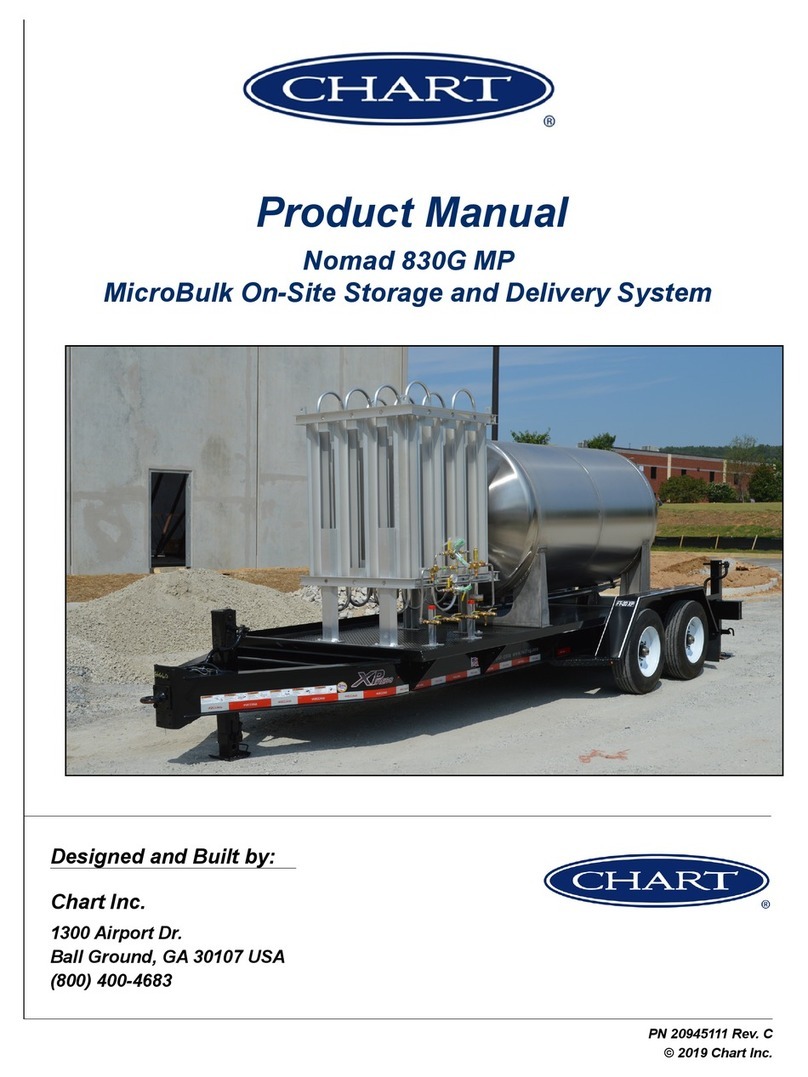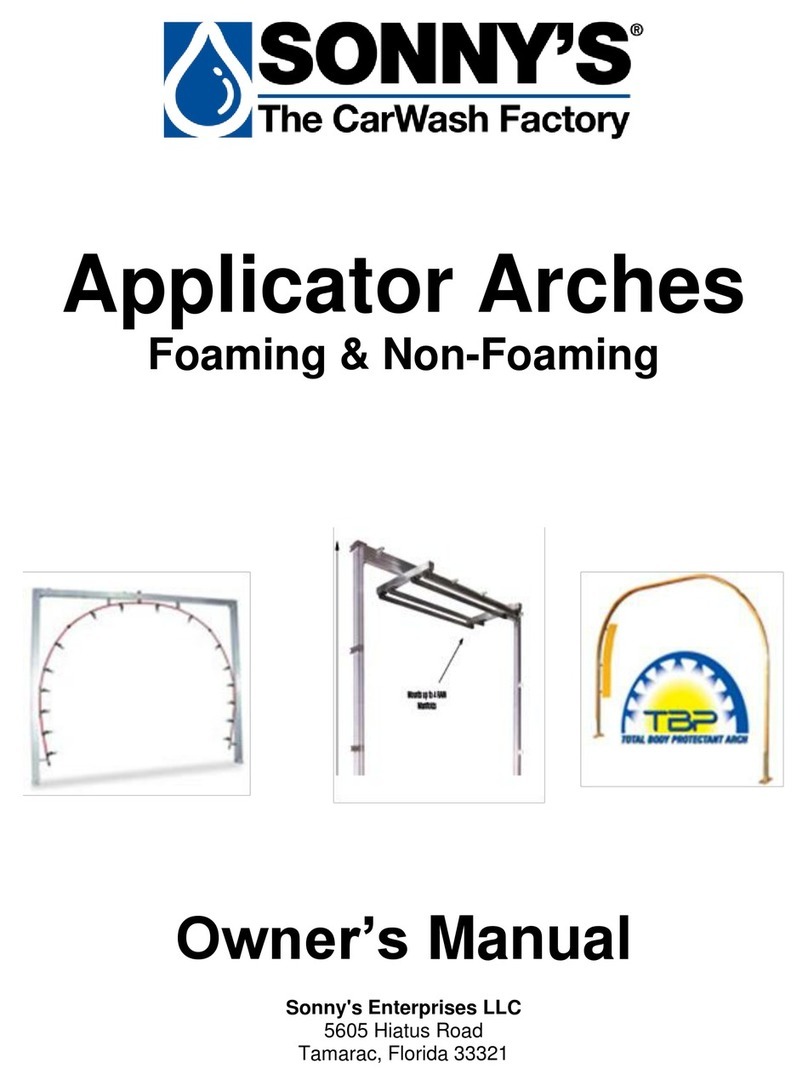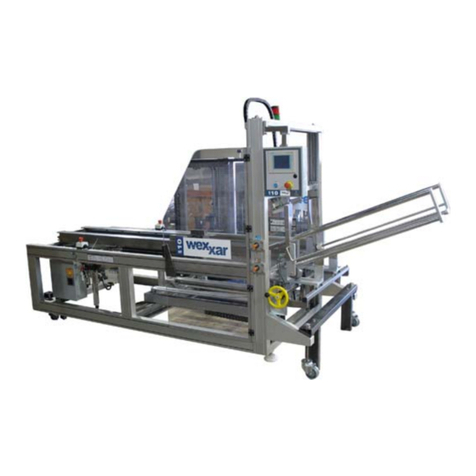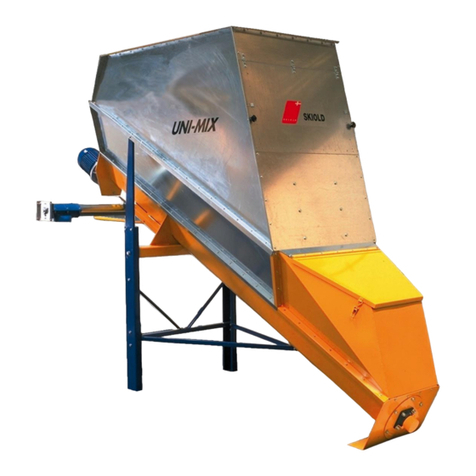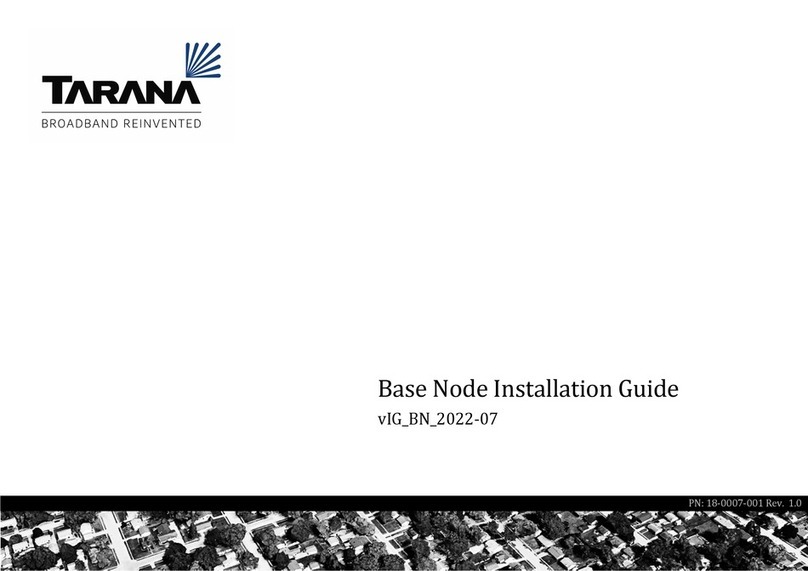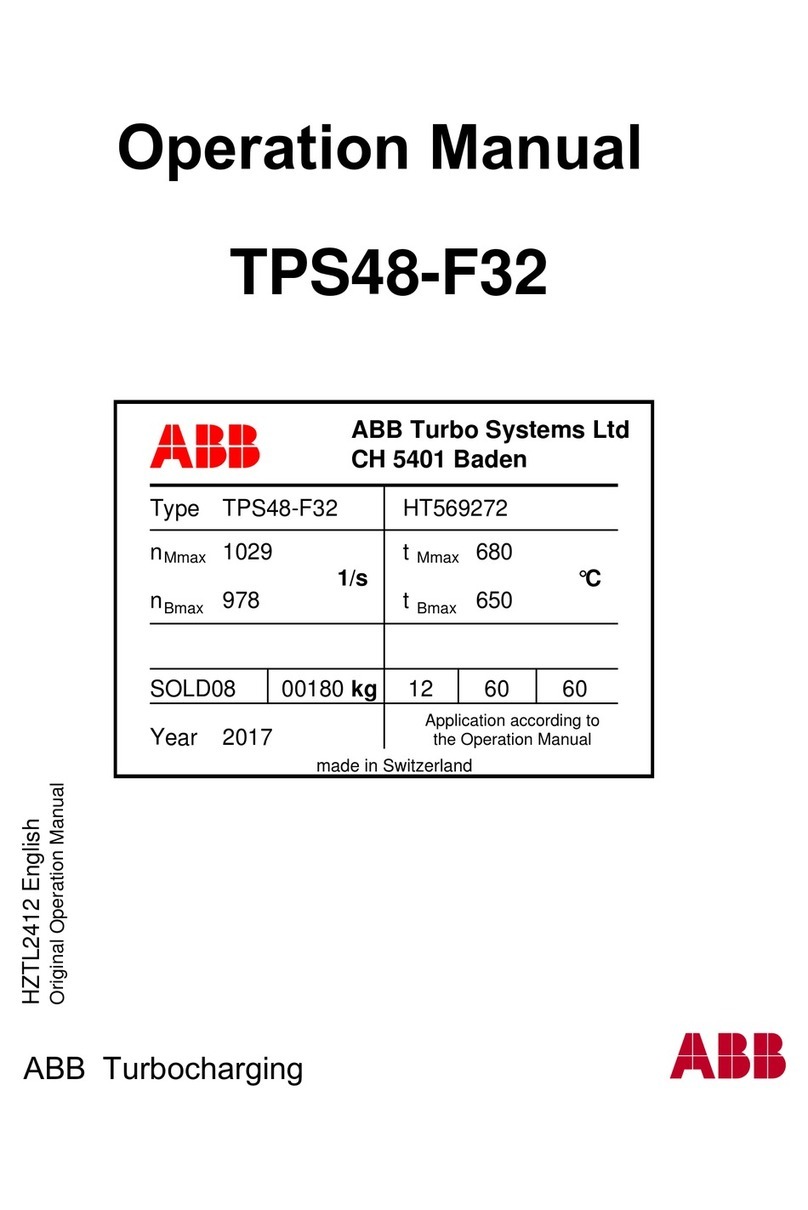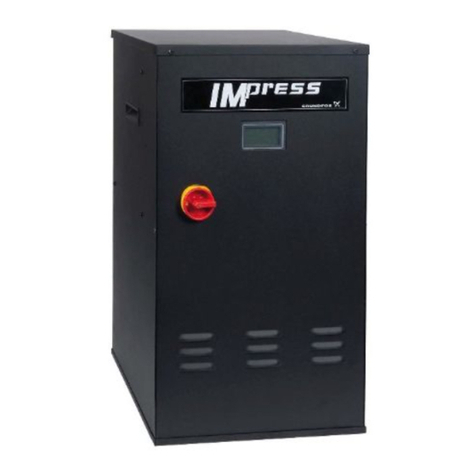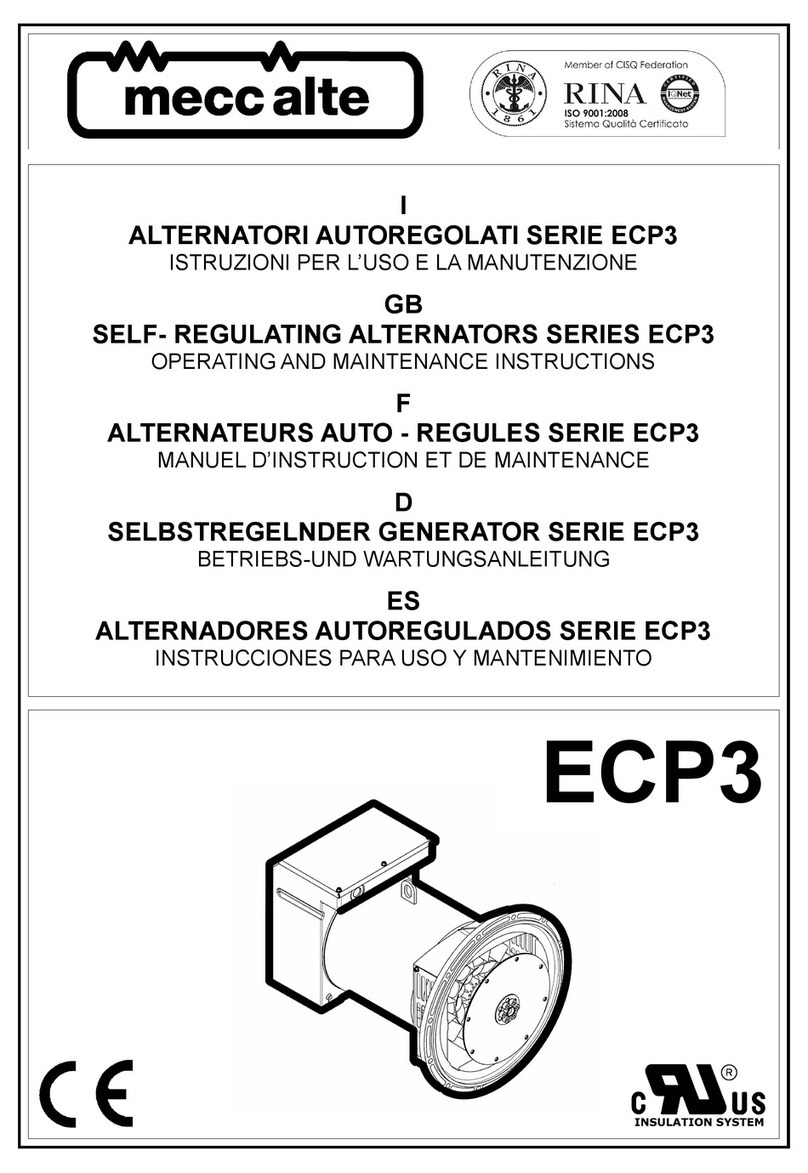Chicago Dryer King Edge User manual

KING EDGETM
Large Piece
Spreader/Feeder
INSTRUCTION MANUAL

©Chicago Dryer Company
Instruction Manual #3018-029d
CHICAGO DRYER COMPANY
2200 N. Pulaski, Chicago, Illinois USA 60639-3737
Telephone: (773) 235-4430 Fax: (773) 235-4439 www.chidry.com

King Edge Table of Contents
i
TABLE OF CONTENTS
CHAPTER 1 INTRODUCTION
1.1 Warranty .................................................................................................. 1-2
1.2 Scope of Manual ..................................................................................... 1-2
1.3 Safety ...................................................................................................... 1-3
Safe Work Habits .................................................................................... 1-3
Safety Features ....................................................................................... 1-4
1.4 Equipment Description ............................................................................ 1-6
Machine Widths ....................................................................................... 1-6
Optional Equipment ................................................................................. 1-6
CHAPTER 2 INSTALLATION
2.1 Site and Utility Requirements .................................................................. 2-2
2.2 Installation Procedures ............................................................................ 2-3
Inspection ................................................................................................ 2-3
Uncrating, Placement and Alignment ...................................................... 2-4
Floor Trough Installation .......................................................................... 2-6
Inlet Conveyor Upper Pulley Installation ................................................. 2-6
Compressed Air Supply Connection ....................................................... 2-7
Electrical Connection .............................................................................. 2-8
2.3 Pre-Operational Checkout ..................................................................... 2-12
Final Protective Wrapper Removal ........................................................ 2-12
Security of Hardware ............................................................................. 2-12
Clean the Corner Photosensors ............................................................ 2-13
Compressed Air Supply Checkout ........................................................ 2-13
Safety Device/Control Function Checkout ............................................ 2-15
Spread/Feed Function Check ............................................................... 2-17
Checkout Completion ............................................................................ 2-18
Cleaning the Unit ................................................................................... 2-18

Table of Contents King Edge
ii
CHAPTER 3 OPERATING GUIDELINES
3.1 Safety Features ....................................................................................... 3-2
Main Disconnect Switch .......................................................................... 3-2
Safety Guards ......................................................................................... 3-2
Safety STOP Buttons .............................................................................. 3-2
Safety Interlock Switches ........................................................................ 3-3
Safety Labels .......................................................................................... 3-3
3.2 Operating Controls .................................................................................. 3-4
3.3 Daily Operating Procedures .................................................................... 3-6
Start-Up ................................................................................................... 3-6
Interconnected Stop Circuit (option) Operation Notes ............................ 3-7
Flatwork Handling ................................................................................... 3-8
Handling Jams and Misfeeds Safely ......................................................3-11
Shut-Down ............................................................................................ 3-12
3.4 Operating Techniques ........................................................................... 3-12
Maximum Efficiency .............................................................................. 3-12
Maximum Feeding Speed ..................................................................... 3-12
CHAPTER 4 PREVENTIVE MAINTENANCE
4.1 Daily PM (8 hours) ................................................................................... 4-2
Watch and Listen for Anything Abnormal ................................................ 4-2
General Cleanliness ................................................................................ 4-2
Check Safety Equipment ......................................................................... 4-3
4.2 Weekly PM (50 hours) ............................................................................. 4-3
Clean The Photosensors and Reflectors ................................................. 4-3
Check and Clean Inverters ...................................................................... 4-4
Check For String Accumulation ............................................................... 4-4
Check Rodless Air Cylinder Bearings ..................................................... 4-4
Inspect Inlet Transfer Rodless Air Cylinder ............................................. 4-5
Check The Clutch-Brake Roller Alignment .............................................. 4-7
Check Spreader Clamp Linear Assembly Bearings ................................ 4-7
Lubricate Upper Spreader Rail, Carriage Rails and Rail Bearings ......... 4-8
Inspect Air Filter/Regulator/Drain ............................................................ 4-9
Check Air Pressure Settings ................................................................... 4-9
Check Ribbon Condition ........................................................................4-11

King Edge Table of Contents
iii
4.3 Monthly PM (200 hours) ........................................................................ 4-12
Clean and Lubricate Drive Chains and Friction Roll Hinge ................... 4-12
Check Upper and Lower Spreader Belt Condition and Tension ............ 4-13
Inspect Drive Belt Condition .................................................................. 4-14
Check Setscrews................................................................................... 4-14
4.4 Semi-Annual PM (1000 hours) .............................................................. 4-14
Clean Air Filter/Drain ............................................................................. 4-15
Check and Grease Bearings ................................................................. 4-16
Replace Rodless Air Cylinder Bearings ................................................ 4-18
4.5 Annual PM (2000 hours) ....................................................................... 4-20
Check All Electrical Connections ........................................................... 4-21
Check Insulation Resistance to Earth Ground ...................................... 4-21
CHAPTER 5 OPERATING PRINCIPLES
Safety ................................................................................................................ 5-2
5.1 Electrical System ..................................................................................... 5-2
Power System ......................................................................................... 5-2
Control System ........................................................................................ 5-9
5.2 Compressed Air System ........................................................................ 5-16
Air Filter/Regulators............................................................................... 5-16
Air Pressure Switch ............................................................................... 5-16
Air Reservoir .......................................................................................... 5-16
Air Valves/Air Valve Solenoids .............................................................. 5-16
Air Cylinders .......................................................................................... 5-17
Flow Controls ........................................................................................ 5-17
Air Bars .................................................................................................. 5-17
Pneumatic Clutch/Brake ........................................................................ 5-17
5.3 Mechanical System ............................................................................... 5-18
Prefeed Drive System ........................................................................... 5-18
Inlet Drive System ................................................................................. 5-19
Spread Drive System ............................................................................ 5-20
Discharge Drive System ........................................................................ 5-21
By-Pass Drive System ........................................................................... 5-21

Table of Contents King Edge
iv
5.4 Sequence of Operation ......................................................................... 5-22
Stand-by Phase ..................................................................................... 5-23
Start-up Phase ...................................................................................... 5-23
Prefeed/Input Phase ............................................................................. 5-24
Transfer Phrase ..................................................................................... 5-24
Spread Phase ....................................................................................... 5-25
Large Piece Discharge Phase ............................................................... 5-25
Small Piece (Bypass Conveyor) Discharge Phase ............................... 5-26
Error Conditions .................................................................................... 5-26
CHAPTER 6 TROUBLESHOOTING
6.1 CHI Diagnostic Message Index ............................................................... 6-6
6.2 LED Diagnostics ...................................................................................... 6-8
6.3 Electrical ................................................................................................ 6-10
6.4 Mechanical ............................................................................................ 6-14
6.5 Prefeed/Inlet Section ............................................................................. 6-15
6.6 Transfer Section .................................................................................... 6-18
6.7 Spread Section ...................................................................................... 6-20
6.8 Discharge Section ................................................................................. 6-24
6.9 Sensor Function .................................................................................... 6-26
6.10 CHI Panel .............................................................................................. 6-27
6.11 Compressed Air System ........................................................................ 6-28
CHAPTER 7 REPAIR
7.1 Safety Considerations ............................................................................. 7-2
7.2 Parts Availability ...................................................................................... 7-2
7.3 Prefeed/Inlet Section ............................................................................... 7-3
Prefeeder Carriage Linear Bearing Adjustment ...................................... 7-3
Prefeeder Carriage Belt Tension Adjustment .......................................... 7-4
Prefeeder Carriage Belt Replacement .................................................... 7-4
Clutch-Brake Roller Alignment ................................................................ 7-5

King Edge Table of Contents
v
7.3 Prefeed/Inlet Section (cont)
Clutch-Brake Roller Drive Belt Tension Adjustment ................................ 7-7
Inlet Conveyor Drive Belt Tension Adjustment ........................................ 7-8
Enabling/Disabling Automatic Misfeed Reject ......................................... 7-8
7.4 Transfer Section ...................................................................................... 7-9
Transfer Clamp Check and Adjustment ................................................... 7-9
Transfer Clamp Assembly Replacement ............................................... 7-12
Transfer Clamp Roller Adjustment ........................................................ 7-14
Rodless Air Cylinder Carrier Bracket Tension Adjustment ..................... 7-15
7.5 Spreader Section .................................................................................. 7-15
Spreader Clamp Mechanical Adjustment .............................................. 7-16
Upper Spreader Belt Tension Adjustment ............................................. 7-16
Upper Spreader Belt Replacement ....................................................... 7-17
Upper Spreader Clamp Linear Bearing Replacement ........................... 7-18
Lower Spreader Drive Belt Tension Adjustment .................................... 7-19
Lower Spreader Drive Belt Replacement .............................................. 7-20
Lower Spreader Belt Replacement ....................................................... 7-20
Lower Spreader Belt Gap Adjustment ................................................... 7-21
7.6 Discharge/ByPass Section .................................................................... 7-23
Discharge/ByPass Conveyors Ribbons Tension Adjustment ................ 7-23
Discharge/ByPass Conveyors Ribbons Replacement .......................... 7-24
Discharge Conveyor Guide Ribbons
Tension Adjustment/Replacement ......................................................... 7-27
Discharge Conveyor Drive Belt Tension Adjustment ............................. 7-28
ByPass Conveyors Drive Belt Tension Adjustment ............................... 7-28
Discharge/ByPass Conveyor Drive Roll
Tracking Tape Replacement .................................................................. 7-29
Discharge Conveyor Doffer Roll Pressure Adjustment .......................... 7-33
Discharge Conveyor Doffer Roll Cover Replacement ........................... 7-34
7.7 Sensors ................................................................................................. 7-36
General Photosensor Alignment ........................................................... 7-36
Corner Photosensors Alignment ........................................................... 7-37
Roller Photosensors Alignment ............................................................. 7-38
Taut Photosensors Alignment ................................................................ 7-39
General Photosensor Sensitivity Adjustment ........................................ 7-40
Roll Photosensors Sensitivity Adjustment ............................................. 7-41

Table of Contents King Edge
vi
7.7 Sensors (cont)
Photosensor Replacement .................................................................... 7-42
Proximity Sensor Positioning Adjustment .............................................. 7-43
Proximity Sensor Replacement ............................................................. 7-44
7.8 Compressed Air System ........................................................................ 7-44
General Air Cylinder Adjustment ........................................................... 7-45
Inlet Clamps Air Pressure Adjustment ................................................... 7-47
Roller Counterpoint Air Pressure Adjustment ........................................ 7-48
Inlet Transfer Rodless Air Cylinder Service ........................................... 7-49
Tighten the Drive T ................................................................................ 7-49
Tighten the Drive Blocks ....................................................................... 7-50
Tighten the Carriage Block .................................................................... 7-51
Increase the Air Cushion ....................................................................... 7-52
Tighten the Inner Band .......................................................................... 7-53
Left Spreader Clamp Air Pressure Adjustment ...................................... 7-56
Air Bar Alignment .................................................................................. 7-57
Air Foil Adjustment ................................................................................ 7-58
Air Laydown Assist (option) Air Pressure Adjustment ........................... 7-59
CHI PANEL BULLETIN
PARTS LIST
SCHEMATICS
APPENDIX

King Edge Introduction
1-1
Chapter 1
INTRODUCTION
This chapter includes the following sections:
1.1 Warranty 1.3 Safety
1.2 Scope of Manual 1.4 Equipment Description
The King Edge automatic cornerless spreader/feeder allows operators to feed sheets or other large
pieces of flatwork into a flatwork ironer or automatic folder from two stations. A built-in bypass conveyor
allows feeding of small pieces through the King Edge without altering the position of the feeder or its
discharge conveyor.
Like the rest of the CHICAGO® product line, the King Edge (Figure 1-1) is designed, manufactured,
and assembled in Chicago, Illinois. Before the CHICAGO® nameplate is affixed to any machine, a final
inspection is performed, including thorough testing under load conditions.
Any questions concerning the installation, operation, or repair of the unit should be directed to a local
authorized CHICAGO® dealer or the Chicago Dryer Company factory Service Department at:
Chicago Dryer Company (773) 235-4430
2200 North Pulaski Fax (773) 235-4439
Chicago, Illinois USA 60639-3737 Email service@chidry.com
Figure 1-1: The King Edge provides high quality spreading and feeding.

Introduction King Edge
1-2
1.1 Warranty
A full page warranty statement is located at
the front of this instruction manual. Please take
the time to review this warranty and understand
its provisions.
1.2 Scope of Manual
This instruction manual will help you keep
your CHICAGO® product operating safely,
efficiently and with minimum expense. Individual
chapters in this manual provide the necessary
information required for safe installation,
operation, maintenance, troubleshooting, and
repair of the unit.
Updates
Occasionally, new information about the
unit becomes available after publication of this
manual. If you receive a CHICAGO® FYI Service
Bulletin pertaining to our unit, insert the bulletin
in the front of the manual.
Chapter 1 - Introduction
Provides an overview of the unit and its key
features, of this manual, and of important safety
features.
Chapter 2 - Installation
Describes recommended procedures for
determining a suitable location for the unit and
connecting the electrical and the compressed air
supplies. This chapter also includes checkout
procedures to ensure all systems are working
properly. Local requirements often vary, so follow
local codes at all times.
Chapter 3 - Operating Guidelines
Gives recommendations for operating the unit
at maximum efficiency. This chapter also includes
instructions for the operators and suggestions for
work organization.
Chapter 4 - Preventive Maintenance
Contains procedures for Daily, Weekly,
Monthly, Semi-Annual, and Annual
maintenance. Follow these procedures to keep the
unit operating safely and at maximum efficiency.
A Preventive Maintenance schedule is located at
the front of the chapter.
Chapter 5 - Operating Principles
Describes the operation of the unit in detail. A
good understanding of this chapter will help avoid
operation errors and assist with trouble shooting
and maintenance.
Chapter 6 - Troubleshooting
Contains issues, possible causes, and solutions
in all areas of operation.
Chapter 7 - Repair
Contains procedures for making adjustments,
repairs and parts replacement for the unit. Please
follow all safety recommendations carefully.
CHI Panel Operation Bulletin
Describes in detail the operation of the
CHI Panel spreading/feeding control system.
Programming, adjustment and test modes are
detailed in this bulletin.
Parts List
Contains detailed drawings and part
specifications to assist in ordering replacement
parts. It is divided into views in which the parts
are grouped by function.
Schematics
Contains electrical drawings showing power
and motor circuits, control circuits and interlock
circuits, and other relevant drawings.
Appendix
Contains Technical Specifications, a Floor
Plan, and other relevant information for the
unit.

King Edge Introduction
1-3
1.3 Safety
Safe operation and maintenance of the unit
must be the first priority of all supervisors,
operators and maintenance personnel. Safety
begins with safe work habits. In addition, the
unit is equipped with built-in features to promote
safety.
Safe Work Habits
During Daily Operation
Take the flatwork only after it has
cleared the unit. Do not pull on the
flatwork while it is still in the machine.
Post the “Operator Safety” reminders
in a place where everyone will see it.
Read these reminders and follow the
recommendations.
Read and follow all safety labels.
Keep hands and clothing away from
the moving parts of the spreader/feeder
while it is operating.
Always turn off the unit before clearing
a jam.
Operate the unit only with all guards and
endframe doors in place and all safety
features operating correctly. Never
operate the unit with any safety features
bypassed.
•
•
•
•
•
•
Maintenance and Repair
WARNING
Always use extreme caution
when performing any repair
procedure that requires the
unit to be operating.
Keep hands and loose
clothing from coming into
contact with any of the
moving parts.
Serious Injury Could Result.
When the unit is running, one
person should be ready at a
red safety STOP button
at all times.
Before attempting any repair work, review
these safety steps and precautions to protect
yourself and the unit.
Safety should be the primary concern
of anyone performing corrective
maintenance.
Except where specifically directed, make
sure that the main disconnect switch to
incoming power is OFF.
It is recommended that all maintenance
procedures be handled by at least two
qualified persons. Using the “buddy
system” decreases the risk of an
accident.
Your site should have procedures that
comply with government regulations and
standards for equipment lockout/tagout
during maintenance and repair. Ask your
supervisor for specific information. It
is the users’ responsibility to make sure
they comply with all safety procedures.
•
•
•
•

Introduction King Edge
1-4
WARNING
Know the proper procedure
for locking out and tagging
equipment during repair
procedures.
Follow the rules of your work
site. Failure to do so could
result in serious injury.
Make sure the power
is disconnected before
servicing the unit.
Do not repair or correct any
condition without reading
and understanding the
REPAIR chapter.
Only qualified personnel
should troubleshoot and
repair this unit.
Safety Features
There are several general categories of safety
features:
Main Disconnect Switch
Safety Guards
Safety Interlock Switches
Safety STOP Buttons
Safety Labels
Safety Messages in the Manual
Main Disconnect Switch
The main disconnect switch is located on the
outside of the main electrical box. When turned
to OFF, this switch shuts off incoming electrical
power to the unit.
Unless otherwise indicated, turn the main
disconnect switch to OFF before performing any
maintenance or repair work.
For more information on operating the main
disconnect switch, refer to the INSTALLATION
chapter, Installation Procedures section,
Electrical Connection procedure.
Safety Guards
A front safety guard runs the entire length of
the unit’s working area and physically restricts
hands from coming into contact with moving
parts.
Both endframes and other appropriate areas
of the unit are covered with protective panels to
prevent fingers or hands from coming into contact
with moving parts. The guards and panels also
serve to keep foreign objects from entering the
unit and damaging components.
When a panel is removed or the front guard is
raised, all rotating parts stop moving.
•
•
•
•
•
•

King Edge Introduction
1-5
Figure 1-2: Safety labels remind operators and
maintenance personnel that care must
be taken when working near these
areas.
Safety Interlock Switches
Safety interlock switches are located behind
each endframe panel and the front guard.
Whenever any of these components is opened or
removed, its associated interlock switch is opened
and all rotating parts stop moving.
The safety interlock switches are not intended
to lockout the unit. Site management is responsible
for developing and implementing lockout/tagout
procedures that comply with government
standards for use when servicing the unit.
Safety STOP Buttons
There are six red safety STOP buttons arrayed
around the unit, one at each corner and one at each
operator station. Pressing any of these buttons
immediately stops all rotating and moving parts,
releases compressed air pressure, and shuts down
the machine. To reset a pressed red safety STOP
button, twist it.
The preferred method of stopping the operation
of the unit is by pressing one of the square red
Stop buttons located at each operator station.
Safety Labels
Orange Warning and yellow Caution labels
(Figure 1-2) are placed at locations around the
unit to keep operators and maintenance personnel
alert in particular areas.
WARNING message labels alert personnel that
personal injury may result from not following
recommended procedures.
CAUTION message labels alert personnel that
the machine may be damaged if conditions,
practices, or procedures are not observed.
When training operators, take the time to
review, understand, and locate all areas where
labels are posted.
NOTE: Do not remove safety
labels at any time. If a label
needs to be replaced, contact
Chicago Dryer Company for free
replacements.

Introduction King Edge
1-6
Safety Messages in this Manual
WARNING and CAUTION messages also
appear in this manual to highlight essential safety
information.
WARNING messages alert personnel that
personal injury may result from not following
recommended procedures.
WARNING
Never bypass any of the
safety devices. This could
result in serious injury.
BLACK BOX WARNING messages alert
personnel of the operating condition a unit
must be in before performing any procedure.
Personal injury may result from not following
recommended procedures.
Perform only when the unit is OFF
with power disconnected.
CAUTION messages alert personnel that the
unit may be damaged if conditions, practices,
or procedures are not observed.
CAUTION
The incoming electric power
must match the electrical
requirements as shown on
the nameplate.
1.4 Equipment Description
A general overview of the King Edge spreader/
feeder includes:
Machine Widths
Optional Equipment
Machine Widths
The King Edge comes in a standard 120” (3050
mm) width. Extra wide models including 130”
(3300 mm), 136” (3455 mm) and wider are also
available for processing California kings, banquet
cloths or other oversized items.
Optional Equipment
The following optional equipment is available
on all models:
Rear Air Bar/Smoothing Brush: Additional
equipment for improving laydown and smoothing
flatwork before it enters the ironer.
Interconnected Stop Circuit: Pressing a red
safety STOP button on the feeder, ironer or folder
stops the entire finishing line.
Variable Speed Interconnect: The speeds of
each machine in a finishing line are automatically
coordinated for maximum efficiency.
Single Point Electrical Connection: Allows
the unit to receive its electrical supply from the
ironer.
Chicago Automatic Reject Processor:
Allows operator to press a stain or tear reject
button after a piece is fed into the unit for
automatic handling by the Chicago® folder at the
end of the finishing line.
Pacing Lights: Allows operating standards
to be set and provides a visual signal to indicate
whether operators are reaching target production
rates.
Lifting Conveyor: Uses compressed air to
raise and position the discharge conveyor.
ChiLinc: Production data collection and
reporting system for archiving and analysis of
production and efficiency information.
•
•

King Edge Installation
2-1
Chapter 2
INSTALLATION
This chapter contains installation instructions for the King Edge spreader/feeder and includes the
following sections:
2.1 Site and Utility Requirements
2.2 Installation Procedures
2.3 Pre-Operational Checkout
The spreader/feeder is tested under load conditions at the factory and inspected to ensure proper
operation. It is shipped in working condition and is completely assembled, requiring only setup of the
exit conveyors. Sufficient strapping, blocking, and bracing were provided to give reasonable assurance
that no shipping damage would occur.
NOTE: If the spreader/feeder is received in damaged condition, notify the carrier
at once.
Chicago Dryer Company’s responsibility for shipping damage, other than the standard warranty,
ceases upon delivery to the carrier. For more information on the warranty, see the full page warranty
statement at the front of this manual.

Installation King Edge
2-2
2.1 Site and Utility
Requirements
Figure 2-1 shows the clearances required for
the spreader/feeder. The dimensions noted are the
minimums recommended for efficient production
and service, as well as maintenance access. It is
strongly recommended that enough clear space
be provided around the spreader/feeder to allow
for efficient access.
NOTE: The correct location of
the spreader/feeder is of extreme
importance.
The site must have a level, sturdy floor capable
of supporting the spreader/feeder’s weight without
significant flexing. For weight specifications
and other technical information refer to the
APPENDIX, Technical Specifications.
No special foundation, floor grouting, or
installation of anchors is required. Generally,
the locking wheels will hold the spreader/feeder
in position and still allow for repositioning
when necessary. Floor grouting or installation
of anchors may be required to comply with local
codes or conditions, or aboard a ship.
Figure 2-1: Recommended clearances for installation of the King Edge.
36”
(915 mm)
36”
(915 mm)
72” (1830 mm)

King Edge Installation
2-3
Compressed air that is clean and dry must
be provided for the unit. This is very important
because the air will blow directly on the flatwork.
The compressed air supply must meet the
pressure and air flow requirements noted in the
APPENDIX, Technical Specifications.
The electrical requirements of the spreader/
feeder are shown on the nameplate (Figure 2-
2), located on the back of the right endframe.
Additional information can be found in the
APPENDIX, Technical Specifications. Wiring
and a separate, fused disconnect switch of suitable
size must be locally supplied if local codes require
one. Check local codes for clearance requirements
to any electrical box.
2.2 Installation
Procedures
The spreader/feeder should be moved on
its casters whenever possible. When this is
impractical, and when removing it from the skids,
be sure that it is handled only by qualified riggers
using proper equipment.
Installation of the spreader/feeder includes:
Inspection
Uncrating, Placement and Alignment
Floor Trough Installation
Inlet Conveyor Upper Pulley Installation
Compressed Air Supply Connection
Electrical Connection
Final Protective Wrapper Removal
Inspection
NOTE: Notify the carrier if
any damage has been done
to the spreader/feeder during
shipment.
It is in the interest of the buyer to carefully
inspect all shipments before they are accepted
from the carrier. Upon delivery, be sure that all
items listed on the bill have been received.
Any shortage, breakage, or damage noticed at
the time of delivery should be indicated on the
carrier’s freight bill and signed by the driver or
carrier’s representative.
Damage noticed after delivery should be
reported to the carrier at once. Request their
inspection of the shipment and fill out a concealed
damage inspection report.
•
•
•
•
•
•
•
Figure 2-2: The nameplate gives important
information about the unit.

Installation King Edge
2-4
Uncrating, Placement and Alignment
Required Tools
forklift, crowbar, sledgehammer, wire
cutters/knife, wrenches
Before unpacking the unit, make sure
that the proposed site is acceptable and
any necessary foundations have been
prepared.
Remove the crating, strapping, and other
packaging materials from the unit. Leave
the protective plastic covers on the con-
trols. These protective coverings should
be left in place until the unit is ready for
use.
Open both endframe doors and remove
any materials that shipped with the unit.
Close and secure the doors.
CAUTION
The unit should only be
moved by qualified riggers
using proper equipment.
With the unit still on its skid, move it into
approximate position. Remove the bolts
which secure the unit to the skid.
CAUTION
Do not drop or twist the unit.
As appropriate:
If the unit is equipped with eye bolts,
lift the unit straight up using the two eye
bolts on top of each endframe and care-
fully remove the skid from under it.
OR
Lift one endframe and carefully re-
move the skid from under it and then
repeat for the other endframe.
1.
2.
3.
4.
5.
•
•
While either the entire unit or one side
of the unit is suspended, attach the lock-
ing floor castors (Figure 2-3) which were
removed for shipping.
NOTE: For units equipped
with the optional discharge lifting
conveyor, follow the steps to
connect the compressed air
supply. Turn ON the compressed
air supply and the discharge
conveyor will automatically
rise. It will still be necessary to
manually position the bypass exit
conveyor.
Carefully lift the bypass and discharge
conveyors. Position the bypass conveyor’s
threaded rod in its tube (Figure 2-4, A).
There is one on each side.
6.
7.
Figure 2-4: Bypass conveyor support and
positioning bolt location.
A
C
B
Figure 2-3: Locking floor casters stored in an
endframe for shipping.

King Edge Installation
2-5
Move the unit into final position in front
of the ironer.
Figure 2-5 shows the desired relative
positioning of the bypass conveyor and
the discharge conveyor idler rolls to the
ironer inlet.
Use the stop nut (Figure 2-4, B) to adjust
the height of the bypass conveyor. Tighten
down the locknut (Figure 2-4, C) to secure
the position.
If necessary, adjust the positioning of the
discharge conveyor by turning its posi-
tioning bolt (Figure 2-6, A). Secure the
adjustment with the stop nut (B).
NOTE: Secure the unit to its
foundation if required by local
code. Always follow local codes.
Set the locking casters.
Attach the provided locking floor pads to
the front crossbar (Figure 2-7, A). There is
one for the left and one for the right side
of the machine.
Adjust each pad so that it will rest firmly
against the floor when fully extended
(Figure 2-7, B). Secure the adjustment by
tightening the locking nut (C).
Push the locking lever (Figure 2-7, D)
fully down to extend the pads and firmly
secure the unit in position.
8.
9.
10.
11.
12.
13.
14.
15.
Ironer inlet
Bypass conveyor
Discharge conveyor
Figure 2-5: Position the bypass exit conveyor so
that it is just slightly higher than the
ironer inlet.
Figure 2-7: The locking floor pads help secure the
unit in position.
A
B
C
D
Figure 2-6: Discharge conveyor positioning bolt.
A
B

Installation King Edge
2-6
Figure 2-10: Two bolts secure the upper pulley arm
in position.
Figure 2-11: After positioning the pulley, roll the
inlet conveyor belt into place.
B
A
Floor Trough Installation
Now it is time to install the floor trough which
will catch wet linen which is dropped during
processing.
Install the four trough brackets which
shipped with the machine, two in front
and two in the back, on the crossbars. If
necessary, push the front bypass conveyor
forward a little to seat the rear brackets.
Position them about 12-18” (305-460 mm)
away from each endframe and facing each
other (Figure 2-8).
Slide the galvanized steel trough into posi-
tion so that it is firmly resting on the sup-
port brackets (Figure 2-9). Make sure the
angled corners face the machine front.
1.
2.
3.
Inlet Conveyor Upper Pulley
Installation
For facilities with low clearance, the inlet
conveyor upper pulleys are sometimes reversed
for shipping (Figure 2-10). They must be correctly
positioned before connecting the utilities.
Required Tools
wrench
Remove the two bolts which secure each
upper pulley arm in position (Figure 2-
10).
Turn the arm so the pulley is on top and
re-install using the same two bolts.
Pull the drive belt over the rim of the pul-
ley (Figure 2-11, A) and roll it into posi-
tion. Make sure it is positioned within the
safety stop mechanism (B).
1.
2.
3.
Figure 2-8: Position the floor troughs facing each
other about 12-18” from the endframe.
Figure 2-9: The angled corners must face front to
accommodate the locking floor pads.
Table of contents
Other Chicago Dryer Industrial Equipment manuals

